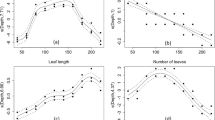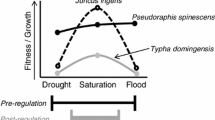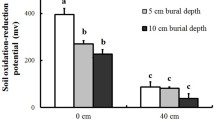Abstract
Temporary dewatering constitutes a drastic change in conditions for aquatic vegetation. Species’ sustained performance under these conditions relies partly on their ability to produce a terrestrial phenotype. Such adaptations may include the development of self-supporting aboveground organs with higher dry matter content enabling plants to withstand gravity and smaller leaves with thicker cuticle to reduce evapotranspiration, leading to lower specific leaf area, higher leaf-construction costs and consequently higher leaf life span. The ability of aquatic plant species to produce a terrestrial-adapted phenotype may differ according to growth form and evolutionary history. The objectives of this study were to (1) measure the effects of dewatering on aquatic plant performance, (2) determine how growth form and phylogenetic position affect performance, and (3) relate plant performance to plasticity. To meet these objectives, we experimentally studied aquatic plant responses to dewatering by measuring survival, growth, and a set of traits describing the morphology and leaf-resource economy of eight aquatic plant species with contrasting phylogeny and growth forms. The ability of aquatic plants to withstand dewatering differed according to phylogeny but not to growth form. The eudicots presented high survival and similar growth rates under terrestrial compared to aquatic conditions, while monocots generally did not survive dewatering. These species produced phenotypic adjustments, such as denser aboveground organs and leaf plasticity, which can explain the maintenance of similar growth rates under terrestrial conditions. The relatively strong plasticity and performance of eudicots in terrestrial habitats suggests that their optimal niche is the interface between aquatic and terrestrial ecosystems.



Similar content being viewed by others
References
Angiosperm Phylogeny Group III (2009) An update of the angiosperm phylogeny group classification for the orders and families of flowering plants: APG III. Bot J Linn Soc 161:105–121
Arthaud F, Vallod D, Robin J et al (2012) Eutrophication and drought disturbance shape functional diversity and life-history traits of aquatic plants in shallow lakes. Aquat Sci 74:471–481
Baldwin DS, Mitchell AM (2000) The effects of drying and re-flooding on the sediment and soil nutrient dynamics of lowland river-floodplain systems. River Res Appl 16:457–467
Barrat-Segretain MH (2001) Biomass allocation in three macrophyte species in relation to the disturbance level of their habitat. Freshw Biol 46:935–945
Bradshaw AD (1965) Evolutionary significance of phenotypic plasticity in plants. Adv Genet 13:115–155
Casanova MT, Brock MA (2000) How do depth, duration and frequency of flooding influence the establishment of wetland plant communities? Plant Ecol 147:237–250
Chambers PA, Lacoul P, Murphy KJ et al (2008) Global diversity of aquatic macrophytes in freshwater. Hydrobiologia 595:9–26
Coleman JS, McConnaughay KDM, Ackerly DD (1994) Interpreting phenotypic variation in plants. Trends Ecol Evol 9:187–191
Cook CDK (1990) Aquatic plant book. SPB Academic Publishing, The Hague
Cook CDK (1999) The number and kinds of embryo-bearing plants which have become aquatic: a survey. Perspect Plant Ecol Evol Syst 2:79–102
De Witt TJ, Sih A, Wilson DS (1998) Costs and limits of phenotypic plasticity. Trends Ecol Evol 13:77–81
Evans GC (1972) The quantitative analysis of plant growth. University of California Press, Oakland
Geber MA, Griffen LR (2003) Inheritance and natural section on functional traits. Int J Plant Sci 164:21–43
Germ M, Gaberščik A (2003) Comparison of aerial and submerged leaves in two amphibious species, Myosotis scorpioides and Ranunculus trichophyllus. Photosynthetica 41:91–96
Grime JP, Mackey JML (2002) The role of plasticity in resource capture by plants. Evol Ecol 16:299–307
Hamann E, Puijalon S (2013) Biomechanical responses of aquatic plants to aerial conditions. Ann Bot 112:1869–1878
Jackson MB, Colmer TD (2005) Response and adaptation by plants to flooding stress. Ann Bot 96:501–505
Janiensky M, Bazzaz FA (1999) The fallacy of ratios and the testability of models in biology. Oikos 84:321–326
Kautsky L (1988) Life strategies of aquatic soft bottom macrophytes. Oikos 53:126–135
Keeley JE (1998) C4 photosynthetic modifications in the evolutionary transition from land to water in aquatic grasses. Oecologia 116:85–97
Les DH, Sheridan DJ (1990) Biochemical heterophylly and flavonoid evolution in North America Potamogeton (Potamogetonaceae). Am J Bot 77:453–465
Li Z, Yu D, Xu J (2011) Adaptation to water level variation: responses of a floating-leaved macrophyte Nymphoides peltata to terrestrial habitat. Ann Limnol Int J Lim 47:97–102
Luo WB, Song FB, Xie YH (2008) Trade-off between tolerance to drought and tolerance to flooding in three wetland plants. Wetlands 28:866–873
Maberly SC, Spence DHN (1989) Photosynthesis and photorespiration in freshwater organisms: amphibious plants. Aquat Bot 34:267–286
Madsen TV, Sand-Jensen K (1991) Photosynthetic carbon assimilation in aquatic macrophytes. Aquat Bot 41:5–40
McConnaughay KDM, Coleman JS (1998) Can plants track changes in nutrient availability via changes in biomass partitioning? Plant Soil 202:201–209
McGill BJ, Enquist BJ, Weiher E et al (2006) Rebuilding community ecology from functional traits. Trends Ecol Evol 21:178–185
Mommer L, Visser EJW (2005) Underwater photosynthesis in flooded terrestrial plants: a matter of leaf plasticity. Ann Bot 96:581–589
Navas ML, Ducout B, Roumet C et al (2003) Leaf life span, dynamics and construction cost of species from Mediterranean old-field differing in successional status. New Phytol 159:213–228
Nielsen SL, Sand-Jensen K (1989) Regulation of photosynthetic rates of submerged rooted macrophytes. Oecologia 81:364–368
Nielsen SL, Sand-Jensen K (1997) Growth rates and morphological adaptations of aquatic and terrestrial forms of amphibious Littorella uniflora (L.) Aschers. Plant Ecol 129:135–140
Niklas KJ (1998) The influence of gravity and wind on land plant evolution. Rev Palaeobot Palynol 102:1–14
Pedersen O, Sand-Jensen K (1993) Water transport in submerged macrophytes. Aquat Bot 44:385–406
Poorter H, Garnier E (1996) Plant growth analysis: an evaluation of experimental design and computational methods. J Exp Bot 47:1343–1351
Puijalon S, Piola F, Bornette G (2008) Abiotic stresses increase plant regeneration ability. Evol Ecol 22:493–506
Rascio N (2002) The underwater life of secondarily aquatic plants: some problems and solutions. Crit Rev Plant Sci 21:401–427
Rattray MR, Howard-Williams C, Brown JMA (1991) Sediment and water as sources of nitrogen and phosphorus for submerged rooted aquatic macrophytes. Aquat Bot 40:225–237
R-Development-Core-Team (2009) R: a language and environment for statistical computing, from http://www.r-project.org.In
Robe WE, Griffiths H (1998) Adaptations for an amphibious life: changes in leaf morphology, growth rate, C and N investment, and reproduction during adjustment to emersion by the freshwater macrophyte Littorella uniflora. New Phytol 140:9–23
Ryser P, Urbas P (2000) Ecological significance of leaf life span among Central European grass species. Oikos 91:41–50
Sand-Jensen K, Frost-Christensen H (1999) Plant growth and photosynthesis in the transition zone between land and stream. Aquat Bot 63:23–35
Sand-Jensen K, Pedersen MF, Nielsen SL (1992) Photosynthetic use of inorganic carbon among primary and secondary water plants in stream. Freshw Biol 27:283–293
Sculthorpe CD (1967) The biology of aquatic vascular plants. Edward Arnold Ltd, London
Shimizu-Sato S, Mori H (2001) Control of outgrowth and dormancy in axillary buds. Plant Physiol 127:1405–1413
Sultan SE (2007) Development in context: the timely emergence of eco-devo. Trends Ecol Evol 22:575–582
Touchette BW, Iannacone LR, Turner GE et al (2007) Drought tolerance versus drought avoidance: a comparison of plant-water relations in herbaceous wetland plants subjected to water withdrawal and repletion. Wetlands 27:656–667
Touchette BW, Frank AR, Iannacone LR et al (2008) Drought susceptibility in emergent wetland angiosperms: a comparison of water deficit growth in five herbaceous perennials. Wetl Ecol Manag 16:485–497
Vasellati V, Oesterheld M, Loreti J (2001) Effects of flooding and drought on the anatomy of Paspalum dilatatum. Ann Bot 88:355–360
Volder A, Bonis A, Grillas P (1997) Effects of drought and flooding on the reproduction of an amphibious plant, Ranunculus peltatus. Aquat Bot 58:13–120
Wells CL, Pigliucci M (2000) Adaptative phenotypic plasticity: the case of heterophylly in aquatic plants. Perspect Plant Ecol Evol Syst 3:1–18
Wright SSD and McConnaughay KDM (2002) Interpreting phenotypic plasticity: the importance of ontogeny. Plant Species Biol 17:119–131
Wright IJ, Reich PB, Westoby M et al (2004) The worldwide leaf economics spectrum. Nature 428:821–827
Acknowledgments
M.R. Viricel is gratefully acknowledged for technical assistance. This research was performed under the aegis of the LTER “Zone Atelier Bassin du Rhône” and was funded by the Wetchange Program (ANR-09-CEP-006-01) of the French National Research Agency (Agence Nationale de la Recherche-ANR).
Author information
Authors and Affiliations
Corresponding author
Rights and permissions
About this article
Cite this article
De Wilde, M., Sebei, N., Puijalon, S. et al. Responses of macrophytes to dewatering: effects of phylogeny and phenotypic plasticity on species performance. Evol Ecol 28, 1155–1167 (2014). https://doi.org/10.1007/s10682-014-9725-8
Received:
Accepted:
Published:
Issue Date:
DOI: https://doi.org/10.1007/s10682-014-9725-8




